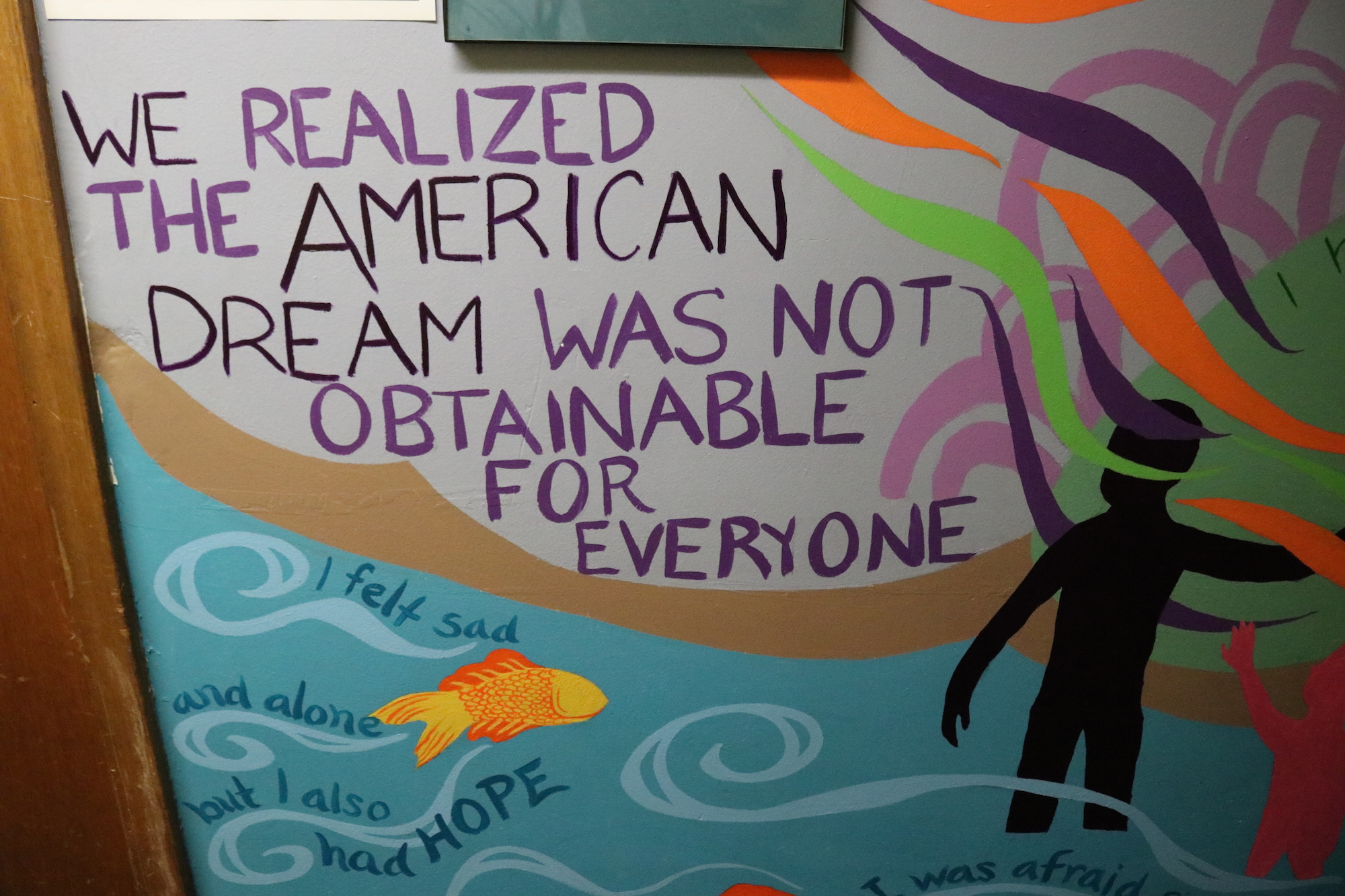
Trying to Fix What's Broken with Immigration
The Trump administration’s war on immigrants has exposed problems within U.S. immigration law that have existed for much longer.
When Sister Mary Kennedy, an accredited legal representative for immigrants at the Aquinas Center in South Philadelphia, visited the border in April 2018, the only word she used to describe what she saw and heard was “unreal.”
She met one woman immigrant who was told, “You’re a traitor to your country. You shouldn’t be here.”
The woman came to the border running for her life, bringing her 10-year old son with her on the 2,500-mile journey from Central America. Back in her home country, her husband was killed the same day that her daughter was raped.
“She knew who did it. She tried to raise a complaint. She got threatened and she had to get out,” said Kennedy.
When they arrived at the U.S.-Mexico border, the woman and her son were detained by one of the many vigilante groups that operated outside of any legal authority at the border.
In response to the traitor charges, the woman said, “Well let me go back,” to which a member of the vigilante group threatened the death of her son as punishment for trying to immigrate to the U.S.
“Can you imagine? To a woman who’s heartbroken already?” asked Kennedy.
Her stories from the short visit to El Paso are just some of the thousands that have come from the border since the election of Donald Trump in 2016. His administration’s “zero-tolerance” approach to immigration has seemingly broken the system.
In response, there is now a more fearful immigrant population seeking the help of immigration lawyers who are both overwhelmed and severely underfunded.
But President Trump didn’t create this issue. His policies have exposed a system that has cracks stretching back several decades, and has built a shaky foundation on a long history of reactionary policies and timely disregard for immigrants.
And it all started in 1961.
That year, a man named Clarence Earl Gideon was arrested and charged with a burglary that happened at a pool hall in Panama City, Florida. Gideon could not afford a lawyer and under Florida law, the state didn’t appoint him counsel.
Gideon had to defend himself in court and lost, but wrote an appeal to the U.S. Supreme Court from his cell in prison. Two years later, Gideon won the resulting case and the public defender system of America was created.
As great as this was for Gideon and other individuals who couldn’t afford a lawyer for their criminal charges, those subject to civil proceedings — including immigration cases — were not granted the same access.
“If you are poor and facing deportation, you might face that process alone,” said Jonah Eaton, an immigration lawyer at the Nationalities Service Center in Philadelphia.
What followed in 1965 was the Hart-Cellar Act, which opened up the U.S. immigration system for more migrants to flow into the country.
But despite what was a rare moment of modern immigration success, the U.S.’s actions as part of the Cold War would create many more problems for the system going forward.
In the 1980s, decades before she made her fateful trip to the U.S.-Mexico border, Sister Mary Kennedy journeyed to Guatemala. She was there on a mission trip for the church and was admittedly out of her element at first.
“The first day I landed there I was like: ‘What am I doing here? I don’t know the language. I don’t know where I’m going,’” she said.
Despite initial doubts, Kennedy learned Spanish and grew to love the people of the country, even as she witnessed the suffering wrought by a genocide perpetrated by the right-wing government against the country’s rural, indigenous communities.
By the time of Kennedy’s visit, the Guatemalan Civil War had waged for almost 30 years. The conflict was started in 1960, when a group of left-wing guerrillas attempted to overthrow the government of then-president Ydigoras Fuentes.
The guerrillas were outraged at Fuentes’ secret aid of the CIA, which trained its force for the failed Bay of Pigs Invasion in Guatemala.
The U.S. would return to the country later in the 60s to train brutal counterinsurgency forces that would support military dictatorships committing genocide.
And Guatemala wasn’t the only place this happened.
From Chile and El Salvador to Nicaragua, Honduras and the Dominican Republic: the U.S. had a hand in supporting dictatorships that destabilized life and stagnated growth for generations throughout Latin America.
This combination is something many of these countries still feel to this day, especially in Central America, and a main reason for the massive migration north.
“We don’t seem to understand here, that America has caused a lot of the conditions in these other countries,” said Kennedy.
The U.S. has only made it worse with the evolution of its immigration policies.
In 1996, faced with massive illegal migration from south of the border, U.S. Congress and President Bill Clinton wanted a solution. What they created was the Illegal Immigration Reform and Immigrant Responsibility Act, IIRIRA for short, or, as Vox’s Dara Lind put it: “immigration enforcement as we know it today, where deportation is a constant and plausible threat to millions of immigrants.”
IIRIRA not only expanded the amount of crimes that made immigrants eligible for deportation, but bypassed many of the legal processes to fast-track deportation.
The 1996 act was an enforcement reaction to the massive influx of immigrants. What followed IIRIRA was a series of counter-reactionary policies that created more visas for immigrants.
Rona Gershon, an immigration lawyer at HIAS Pennsylvania, said that while many of these visas do help immigrants, their implementation has depended on when it is beneficial for the government.
Gershon added that in addition to this “piecemeal” approach to immigration reform, Congress has also failed to create enough funding.
The lack of money means there are fewer attorneys to do the work at affordable prices for immigrants, especially those who find themselves in detention centers and without a source of income.
It’s what spawns the reality of children having to represent themselves in court.
And in the void of service lies yet another threat.
For as many good immigration lawyers as there are to help immigrants toward citizenship, there are more than a few bad ones who will get them deported.
Notarios are individuals who present themselves to immigrants as capable lawyers, but have no qualifications and who “really have no idea what they’re doing,” said David Bennion, an immigration lawyer and founder of the Free Migration Project.
And even some licensed attorneys can give equally bad advice, according to Bennion.
The only bulwark against any type of notario or attorney fraud in the Philadelphia area is Justice at Work.
Evy Tolentino, a paralegal at the organization, said fraud of this nature is a “huge problem.” So much so, that Justice at Work cannot handle every case it is presented and limits itself to the high-impact proceedings — ones involving lots of money and large groups of victims.
It’s also hard to prove that an attorney lied, said Tolentino, making it very difficult to get a favorable ruling in court against a notario or bad lawyer.
Jaya Ramji-Nogales, a law professor at Temple University and former board member of Esperanza’s Immigration Legal Services branch, says the government can do more to weed out the frauds.
RELATED CONTENT
Her answer is the G-28 form. It is used to announce the appearance of an attorney or accredited representative in immigration court on behalf of an immigrant. The form can be used by the government to regulate fraudulent attorneys in the same way the bar does.
“The Department of Justice could be regulating and could be investigating and could be making sure people aren’t getting scammed, but it’s just not,” said Ramji-Nogales.
Only one case pursued by Justice at Work has ever resulted in criminal charges, and the attorney implicated wasn’t disbarred.
Despite the anticlimactic result, it was a small victory. And in the sea of dysfunction that has surrounded immigration for much longer than Donald Trump, there are other small victories to celebrate.
At Villanova University, with more than 20 years in immigration law, professor Michele Pistone was fed up.
“I was angry and ashamed our system doesn’t value justice or truth,” she said.
Noticing the lack of representation for immigrants in court, Pistone formulated a way to diversify career paths in the law industry to combat the shortage. Her answer is the “accredited representative.”
Accredited representatives are established under law as capable of filling in for some or all of the work done by immigration attorneys. Partially accredited reps can provide legal counsel, while fully accredited reps can also litigate in immigration court.
Pistone’s new pilot program, the Villanova Interdisciplinary Immigration Studies Training for Advocates (VIISTA), seeks to train partially and fully accredited reps to fill the gap in immigration legal services.
The pilot finished its first semester in the spring of 2019 and looks to launch in the fall of 2020.
Pistone cited a 2015 University of Pennsylvania study, which analyzed the access to legal counsel for immigrants nationwide between 2007 and 2012, as the impetus for starting VIISTA. It found that 86% of detained immigrants and 63% outside of detention appeared in immigration court without legal representation.
Of those not represented, only 2% detained had a successful outcomes in their cases and 17% outside of detention won their cases.
“Having an advocate is crucial to saving families,” said Pistone.
The same study was used by a coalition of organizations across Philadelphia to advocate for the city to dedicate public funds for immigration representation.
The first city in the U.S. to dedicate public funds to immigration lawyers was New York City, thanks to Judge Robert Katzmann in 2014.
Since then, New York’s system of immigration representation has become a model that has inspired a movement across the country.
“It’s called civil-Gideon,” said Jonah Eaton of Nationalities Services Center, referencing Gideon v. Wainwright.
On July 16, Philadelphia joined the movement by partnering with the Vera Institute, a New York-based justice organization, to become part of its SAFE network and provide public funding for immigration legal representation.
“It’s in line with the administration’s philosophy about equality and due process, and the values that this country and this city were built upon,” said Miriam Enriquez, executive director of Philadelphia’s Office of Immigrant Affairs.
The SAFE network is comprised of a number of cities and counties across the country that have dedicated public funds to immigration legal representation. Potential cities must apply and are selected to receive a grant.
Shayna Kessler, senior program associate at Vera, says the network receives many applications from cities and counties throughout the U.S. that are both geographically and politically diverse.
“It’s a real strong marker of how much support there is across the country for this issue,” she said.
Philadelphia matched the $100,000 grant provided by Vera for a total of $200,000 in funding for a pilot program. The amount is small, but it’s a start in Pennsylvania.
“Our hope would be that other jurisdictions in the state will follow Philadelphia’s lead,” she said.











LEAVE A COMMENT:
Join the discussion! Leave a comment.